Sequence diagram |
|
The Sequence Diagram models the collaboration of objects based on a time sequence. It shows how the objects interact with others in a particular scenario of a use case. With the advanced visual modeling capability, you can create complex sequence diagram in few clicks. Besides, Visual Paradigm can generate sequence diagram from the flow of events which you have defined in the use case description.
|
|
|
Use case diagram
|
Class diagram
|
Sequence diagram
|
Communication diagram
|
State machine diagram
|
Activity diagram
|
Component diagram
|
Deployment diagram
|
Package diagram
|
Object diagram
|
Composite structure diagram
|
Timing diagram
|
Interaction overview diagram
|
|
|
|
|
Sequence diagram |
|
|
|
Notation
 | | Actor |  | | Alternative Combined Fragment | |  | | Call Message |  | | Concurrent | |  | | Constraint |  | | Continuation | |  | | Create Message |  | | Destroy Message | |  | | Duration Constraint |  | | Duration Message | |  | | Found Message |  | | Frame | |  | | Gate |  | | Interaction Use | |  | | LifeLine |  | | LifeLine <<Boundary>> | |  | | LifeLine <<Control>> |  | | LifeLine <<Entity>> | |  | | Loop Combined Fragment |  | | Lost Message | |  | | Message |  | | Note | |  | | Return Message |  | | Send Message | |  | | Sequence Message |  | | Recursive Message | |  | | Reentrant Message |  | | Self Message | |  | | Time Constraint | |
| DefinitionThe Sequence Diagram models the collaboration of objects based on a time sequence. It shows how the objects interact with others in a particular scenario of a use case. With the advanced visual modeling capability, you can create complex sequence diagram in few clicks. Besides, Visual Paradigm can generate sequence diagram from the flow of events which you have defined in the use case description. |
|
| |
Actor | |  | | Definition | An Actor models a type of role played by an entity that interacts with the subject (e.g., by exchanging signals and data), but which is external to the subject (i.e., in the sense that an instance of an actor is not a part of the instance of its corresponding subject). Actors may represent roles played by human users, external hardware, or other subjects. Note that an actor does not necessarily represent a specific physical entity but merely a particular facet (i.e., "role") of some entity that is relevant to the specification of its associated use cases. Thus, a single physical instance may play the role of several different actors and, conversely, a given actor may be played by multiple different instances.
Since an actor is external to the subject, it is typically defined in the same classifier or package that incorporates the subject classifier |
| | Properties | | | Name | The name of actor. | | Documentation | Description of actor. | | Abstract | If true, the actor does not provide a complete declaration and can typically not be instantiated. An abstract actor is intended to be used by other actors. | | Leaf | Indicates whether it is possible to further specialize an actor. If the value is true, then it is not possible to further specialize the actor. | | Root | Indicates whether the actor has no ancestors. (true for no ancestors) | | Business model | Set it to make the actor become a "business actor" | | Attributes | Refers to all of the Properties that are direct (i.e., not inherited or imported) attributes of the actor. | | Operations | An operation is a behavioral feature of an actor that specifies the name, type, parameters, and constraints for invoking an associated behavior. Operations here refers to the operations owned by the actor. |
|
|
|
|
| |
Alternative Combined Fragment | | 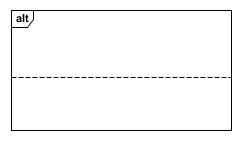 | | Definition | A combined fragment defines an expression of interaction fragments. A combined fragment is defined by an interaction operator and corresponding interaction operands. Through the use of CombinedFragments the user will be able to describe a number of traces in a compact and concise manner.
An alternative combined fragment represents a choice of behavior. At most one of the operands will be chosen. |
| | Properties | | | Name | The name of alternative combined fragment. | | Operator Kind | Specifies the operation that defines the semantics of this combination of InteractionFragments. | | Documentation | Description of alternative combined fragment. | | Interaction Operands | The set of operands of the combined fragment. | | Covered LifeLines | The set of lifelines contained by the combined fragment. |
|
|
|
|
| |
Call Message | |  | | Definition | A message defines a particular communication between Lifelines of an Interaction.
Call message is a kind of message that represents an invocation of operation of target lifeline. |
| | Properties | | | Name | The name of message. | | Action Type | Type action type of the message. | | Return Value | The information to return to caller. | | Sequence No. | The number of message indicates the order of message within an interaction. | | Documentation | Description of message. | | Asynchronous | Determines whether the message is an asynchronous or a synchronous message. |
|
|
|
|
| |
Concurrent | |  | | Definition | | A concurrent represents a session of concurrent method invocation along an activation. It is placed on top of an activation. |
| | Properties | | | Name | The name of concurrent. | | Base Classifier | A classifier is a classification of instances. | | Multiplicity | Specifies the allowable cardinalities for an instantiation of concurrent. | | Documentation | Description of concurrent. |
|
|
|
|
| |
Constraint | | 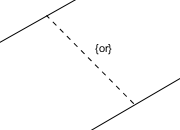 | | Definition | | A condition or restriction expressed in natural language text or in a machine readable language for the purpose of declaring some of the semantics of an element. |
| | Properties | | | Name | The name of constraint. It is optional and is commonly omitted. | | Expression | The condition that must be true when evaluated in order for the constraint to be satisfied. | | Documentation | Description of constraint. |
|
|
|
|
| |
Continuation | |  | | Definition | | A Continuation is a syntactic way to define continuations of different branches of an Alternative CombinedFragment. Continuation is intuitively similar to labels representing intermediate points in a flow of control. |
| | Properties | | | Name | The name of continuation. | | Documentation | Description of continuation. | | Setting | True when the continuation is at the end of the enclosing interaction fragment and false when it is in the beginning. | | Covered LifeLine | The set of lifelines contained by the continuation. |
|
|
|
|
| |
Create Message | | 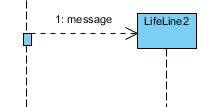 | | Definition | A message defines a particular communication between Lifelines of an Interaction.
Create message is a kind of message that represents the instantiation of (target) lifeline. |
| | Properties | | | Name | The name of message. | | Sequence No. | The number of message indicates the order of message within an interaction. | | Documentation | Description of message. | | Asynchronous | Determines whether the message is an asynchronous or a synchronous message. |
|
|
|
|
| |
Destroy Message | |  | | Definition | A message defines a particular communication between Lifelines of an Interaction.
Destroy message is a kind of message that represents the request of destroying the lifecycle of target lifeline. |
| | Properties | | | Name | The name of message. | | Action Type | Type action type of the message. | | Return Value | The information to return to caller. | | Sequence No. | The number of message indicates the order of message within an interaction. | | Documentation | Description of message. | | Asynchronous | Determines whether the message is an asynchronous or a synchronous message. |
|
|
|
|
| |
Duration Constraint | |  | | Definition | | A DurationConstraint defines a Constraint that refers to a DurationInterval. |
| | Properties | | | Name | The name of constraint. | | Specification | A duration used to determine whether the constraint is satisfied. | | Documentation | Description of constraint. |
|
|
|
|
| |
Duration Message | |  | | Definition | A message defines a particular communication between Lifelines of an Interaction.
Duration message shows the distance between two time instants for a message invocation. |
| | Properties | | | Name | The name of message. | | Action Type | Type action type of the message. | | Return Value | The information to return to caller. | | Sequence No. | The number of message indicates the order of message within an interaction. | | Documentation | Description of message. | | Asynchronous | Determines whether the message is an asynchronous or a synchronous message. |
|
|
|
|
| |
Found Message | |  | | Definition | | A found message is a message where the receiving event occurrence is known, but there is no (known) sending event occurrence. We interpret this to be because the origin of the message is outside the scope of the description. This may for example be noise or other activity that we do not want to describe in detail. |
| | Properties | | | Name | The name of found message. | | Action Type | Type action type of the message. | | Return Value | The information to return to caller. | | Sequence No. | The number of message indicates the order of message within an interaction. | | Documentation | Description of lost message. | | Asynchronous | Determines whether the message is an asynchronous or a synchronous message. |
|
|
|
|
| |
Frame | |  | | Definition | | A frame represents an interaction, which is a unit of behavior that focuses on the observable exchange of information between ConnectableElements. |
| | Properties | | | Name | The name of frame. | | Type | The type of interaction. For example, sd for sequence diagram. | | Documentation | Description of lost message. | | Children | Specifies the participants in this Interaction. | | Gates | Specifies the gates that form the message interface between this Interaction and any InteractionUses that reference it. |
|
|
|
|
| |
Gate | |  | | Definition | | A Gate is a connection point for relating a Message outside an InteractionFragment with a Message inside the InteractionFragment. |
| | Properties | | | Name | The name of gate. | | Documentation | Description of gate. |
|
|
|
|
| |
Interaction Use | | 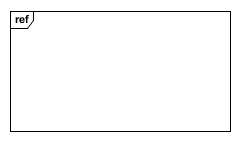 | | Definition | | An InteractionUse refers to an Interaction. The InteractionUse is a shorthand for copying the contents of the referred Interaction where the InteractionUse is. To be accurate the copying must take into account substituting parameters with arguments and connect the formal gates with the actual ones. |
| | Properties | | | Name | The name of interaction use. | | Return Value | The information to return to caller. | | Refers To | Refers to the Interaction that defines its meaning. | | Documentation | Description of interaction use. | | Attribute | Attribute refers to an attribute of one of the lifelines in the Interaction. | | Arguments | The actual arguments of the Interaction. | | Duration Constraint | A duration constraint defines a constraint that refers to a duration interval. | | Covered LifeLines | The set of lifelines contained by the continuation. |
|
|
|
|
| |
LifeLine | |  | | Definition | | A lifeline represents an individual participant in the Interaction. |
| | Properties | | | Name | The name of lifeline. | | Base Classifier | A classifier is a classification of instances. | | Multiplicity | Specifies the allowable cardinalities for an instantiation of this lifeline. | | Documentation | Description of lifeline. | | Active | An active object is an object that, as a direct consequence of its creation, commences to execute its classifier behavior, and does not cease until either the complete behavior is executed or the object is terminated by some external object. | | Stopped | If a lifeline it stopped, this represents that the lifeline has received a destruction event. | | Multi-Object | A multiobject represents a set of lifeline instances. | | Attribute Links | A lifeline can be an instance that originates from a class. It is structured and behaves according to its class. An attribute link refers to an attribute, if any, defined in base classifier, with initial value specified. |
|
|
|
|
| |
LifeLine <<Boundary>> | | 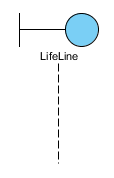 | | Definition | | A lifeline represents an individual participant in the Interaction. |
| | Properties | | | Name | The name of lifeline. | | Base Classifier | A classifier is a classification of instances. | | Multiplicity | Specifies the allowable cardinalities for an instantiation of this lifeline. | | Documentation | Description of lifeline. | | Active | An active object is an object that, as a direct consequence of its creation, commences to execute its classifier behavior, and does not cease until either the complete behavior is executed or the object is terminated by some external object. | | Stopped | If a lifeline it stopped, this represents that the lifeline has received a destruction event. | | Multi-Object | A multiobject represents a set of lifeline instances. | | Attribute Links | A lifeline can be an instance that originates from a class. It is structured and behaves according to its class. An attribute link refers to an attribute, if any, defined in base classifier, with initial value specified. |
|
|
|
|
| |
LifeLine <<Control>> | |  | | Definition | | A lifeline represents an individual participant in the Interaction. |
| | Properties | | | Name | The name of lifeline. | | Base Classifier | A classifier is a classification of instances. | | Multiplicity | Specifies the allowable cardinalities for an instantiation of this lifeline. | | Documentation | Description of lifeline. | | Active | An active object is an object that, as a direct consequence of its creation, commences to execute its classifier behavior, and does not cease until either the complete behavior is executed or the object is terminated by some external object. | | Stopped | If a lifeline it stopped, this represents that the lifeline has received a destruction event. | | Multi-Object | A multiobject represents a set of lifeline instances. | | Attribute Links | A lifeline can be an instance that originates from a class. It is structured and behaves according to its class. An attribute link refers to an attribute, if any, defined in base classifier, with initial value specified. |
|
|
|
|
| |
LifeLine <<Entity>> | |  | | Definition | | A lifeline represents an individual participant in the Interaction. |
| | Properties | | | Name | The name of lifeline. | | Base Classifier | A classifier is a classification of instances. | | Multiplicity | Specifies the allowable cardinalities for an instantiation of this lifeline. | | Documentation | Description of lifeline. | | Active | An active object is an object that, as a direct consequence of its creation, commences to execute its classifier behavior, and does not cease until either the complete behavior is executed or the object is terminated by some external object. | | Stopped | If a lifeline it stopped, this represents that the lifeline has received a destruction event. | | Multi-Object | A multiobject represents a set of lifeline instances. | | Attribute Links | A lifeline can be an instance that originates from a class. It is structured and behaves according to its class. An attribute link refers to an attribute, if any, defined in base classifier, with initial value specified. |
|
|
|
|
| |
Loop Combined Fragment | | 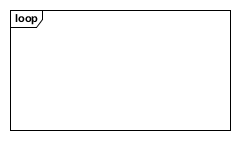 | | Definition | A combined fragment defines an expression of interaction fragments. A combined fragment is defined by an interaction operator and corresponding interaction operands. Through the use of CombinedFragments the user will be able to describe a number of traces in a compact and concise manner.
A loop combined fragment represents a loop. The loop operand will be repeated a number of times. |
| | Properties | | | Name | The name of loop combined fragment. | | Operator Kind | Specifies the operation that defines the semantics of this combination of InteractionFragments. | | Documentation | Description of loop combined fragment. | | Interaction Operands | The set of operands of the combined fragment. | | Covered LifeLines | The set of lifelines contained by the combined fragment. |
|
|
|
|
| |
Lost Message | |  | | Definition | | A lost message is a message where the sending event occurrence is known, but there is no receiving event occurrence. We interpret this to be because the message never reached its destination. |
| | Properties | | | Name | The name of lost message. | | Action Type | Type action type of the message. | | Return Value | The information to return to caller. | | Sequence No. | The number of message indicates the order of message within an interaction. | | Documentation | Description of lost message. | | Asynchronous | Determines whether the message is an asynchronous or a synchronous message. |
|
|
|
|
| |
Message | |  | | Definition | | A message defines a particular communication between Lifelines of an Interaction. |
| | Properties | | | Name | The name of message. | | Action Type | Type action type of the message. | | Return Value | The information to return to caller. | | Sequence No. | The number of message indicates the order of message within an interaction. | | Documentation | Description of message. | | Asynchronous | Determines whether the message is an asynchronous or a synchronous message. |
|
|
|
|
| |
Note | |  | | Definition | | A note (comment) gives the ability to attach various remarks to elements. A comment carries no semantic force, but may contain information that is useful to a modeler. |
| | Properties | | | Name | The name of note. | | Documentation | Specifies a string that is the comment. |
|
|
|
|
| |
Return Message | |  | | Definition | A message defines a particular communication between Lifelines of an Interaction.
Return message is a kind of message that represents the pass of information back to the caller of a corresponded former message. |
| | Properties | | | Name | The name of message. | | Action Type | Type action type of the message. | | Return Value | The information to return to caller. | | Sequence No. | The number of message indicates the order of message within an interaction. | | Documentation | Description of message. | | Asynchronous | Determines whether the message is an asynchronous or a synchronous message. |
|
|
|
|
| |
Send Message | |  | | Definition | A message defines a particular communication between Lifelines of an Interaction.
Send message is a kind of message that represents the start of execution. |
| | Properties | | | Name | The name of message. | | Action Type | Type action type of the message. | | Return Value | The information to return to caller. | | Sequence No. | The number of message indicates the order of message within an interaction. | | Documentation | Description of message. | | Asynchronous | Determines whether the message is an asynchronous or a synchronous message. |
|
|
|
|
| |
Sequence Message | |  | | Definition | A message defines a particular communication between Lifelines of an Interaction.
Sequence message is a kind of message that represents the need of performing actions in sequence. |
| | Properties | | | Name | The name of message. | | Action Type | Type action type of the message. | | Return Value | The information to return to caller. | | Sequence No. | The number of message indicates the order of message within an interaction. | | Documentation | Description of message. | | Asynchronous | Determines whether the message is an asynchronous or a synchronous message. |
|
|
|
|
| |
Recursive Message | |  | | Definition | A message defines a particular communication between Lifelines of an Interaction.
Recursive message is a kind of message that represents the invocation of message of the same lifeline. It's target points to an activation on top of the activation where the message was invoked from. |
| | Properties | | | Name | The name of message. | | Action Type | Type action type of the message. | | Return Value | The information to return to caller. | | Sequence No. | The number of message indicates the order of message within an interaction. | | Documentation | Description of message. | | Asynchronous | Determines whether the message is an asynchronous or a synchronous message. |
|
|
|
|
| |
Reentrant Message | |  | | Definition | A message defines a particular communication between Lifelines of an Interaction.
A reentrant message points to an activation on top of another activation. |
| | Properties | | | Name | The name of message. | | Action Type | Type action type of the message. | | Return Value | The information to return to caller. | | Sequence No. | The number of message indicates the order of message within an interaction. | | Documentation | Description of message. | | Asynchronous | Determines whether the message is an asynchronous or a synchronous message. |
|
|
|
|
| |
Self Message | |  | | Definition | A message defines a particular communication between Lifelines of an Interaction.
Self message is a kind of message that represents the invocation of message of the same lifeline. |
| | Properties | | | Name | The name of message. | | Action Type | Type action type of the message. | | Return Value | The information to return to caller. | | Sequence No. | The number of message indicates the order of message within an interaction. | | Documentation | Description of message. | | Asynchronous | Determines whether the message is an asynchronous or a synchronous message. |
|
|
|
|
| |
Time Constraint | |  | | Definition | | A TimeConstraint defines a Constraint that refers to a TimeInterval. |
| | Properties | | | Name | The name of constraint. | | Specification | A time expression used to determine whether the constraint is satisfied. | | Documentation | Description of time constraint. |
|
|
|
|
| |
| Definition of notations is quoted from Object Management Group Unified Modeling Language (OMG UML) Superstructure Version 2.2 and former versions (for notations that do not exist anymore in latest specification). |
| |
|
Use case diagram
|
Class diagram
|
Sequence diagram
|
Communication diagram
|
State machine diagram
|
Activity diagram
|
Component diagram
|
Deployment diagram
|
Package diagram
|
Object diagram
|
Composite structure diagram
|
Timing diagram
|
Interaction overview diagram
|



